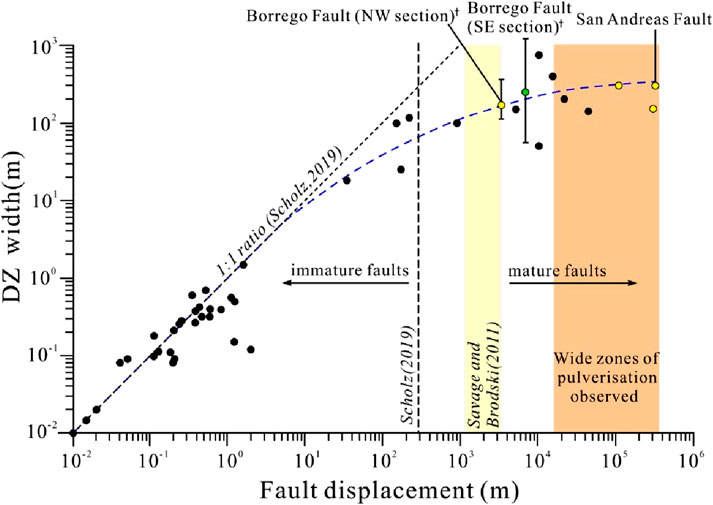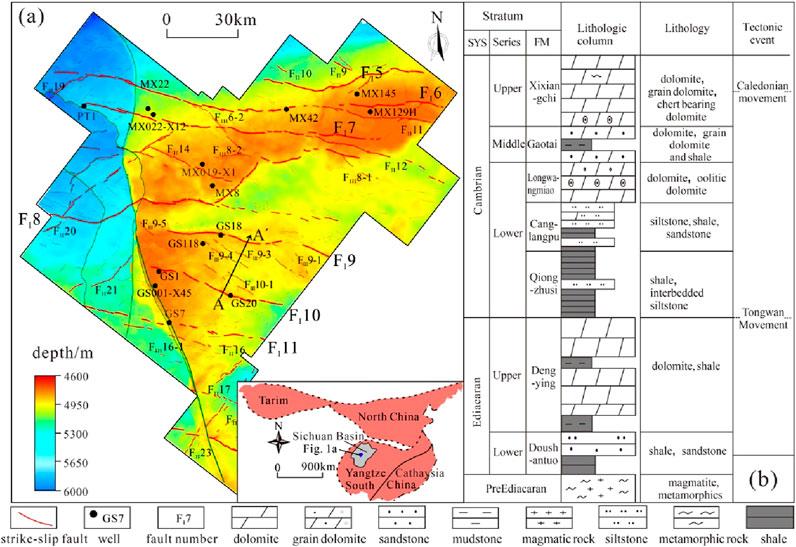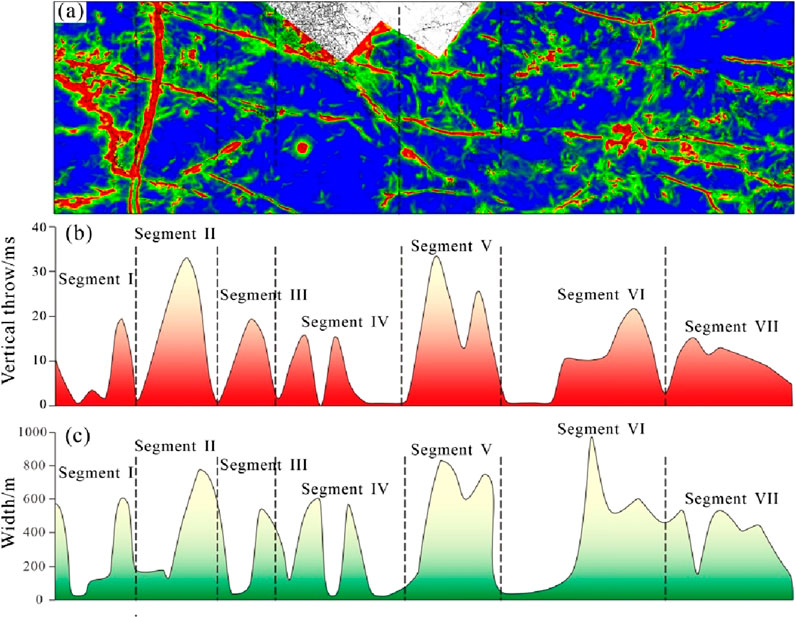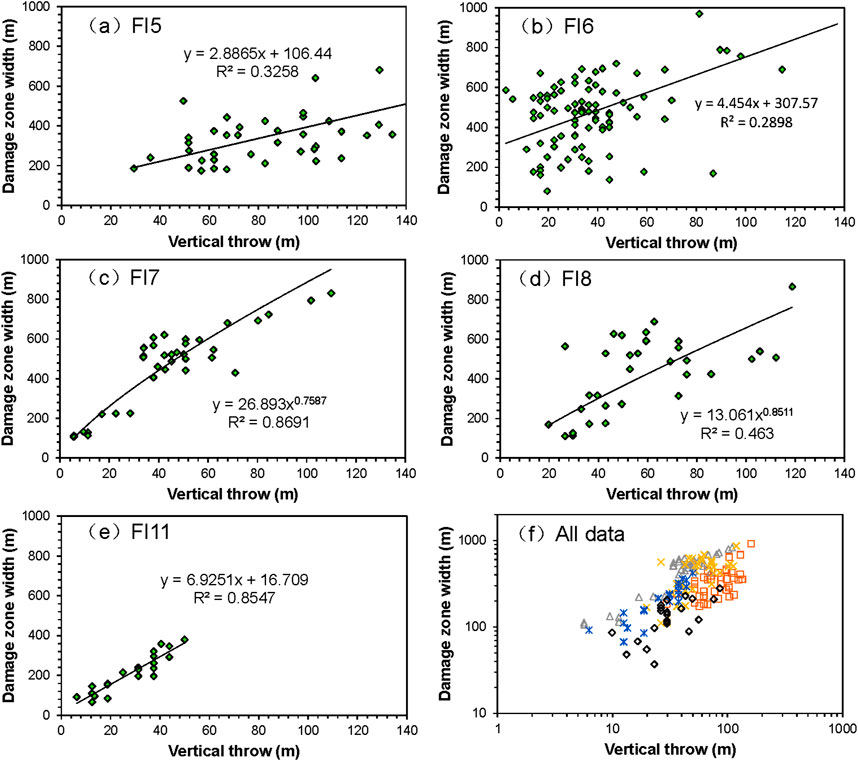- 1School of Geoscience and Technology, Southwest Petroleum University, Chengdu, China
- 2PetroChina Southwest Oil & Gasfield Company, Chengdu, China
Immature faults typically exhibit a linear scaling between damage zone width and displacement up to a certain displacement threshold. However, the nature and precise value of this threshold remain debated. In this study, we investigate five immature strike-slip fault damage zones and their scaling relationships in the central Sichuan Basin using seismic data. The widths of the seismic damage zones are consistent with borehole data and show a correlation with the vertical displacement (throw) in Ediacaran carbonate rocks. The damage zone widths are found to be approximately 3–7 times larger than the vertical throw, exhibiting an overall linear scaling relationship. As the vertical throw increases, three of the faults maintain this linear scaling with increased data scatter. In contrast, two faults display a power-law transition in scaling when the vertical throw ranges from 50 m to 80 m and then return to a linear trend once the throw exceeds 130 m. Notably, the transition in scaling emerges when the damage zone width exceeds 600 m. These findings suggest that the scaling transition between fault damage zone width and displacement cannot be constrained by a fixed displacement threshold. Furthermore, the damage zones of immature strike-slip faults may exhibit variable off-fault damage evolution, transitioning from linear to power-law scaling as displacement increases.
1 Introduction
The structural architecture of fault zones generally includes an off-fault damage zone composed of highly fractured rocks, with fracture intensity increasing toward the fault core. These zones significantly influence the mechanical, hydraulic, and seismological properties of faults (Kim et al., 2004; Mitchell and Faulkner, 2009; Ostermeijer et al., 2022). Studies have shown that fault damage zone width, along with fracture density and petrophysical characteristics, tends to increase with fault displacement (Mitchell and Faulkner, 2009; Ostermeijer et al., 2022; Torabia and Berg, 2011; Mayolle et al., 2019; Wu et al., 2020). A transition in scaling has been observed, from linear to power-law or plateau behavior, between damage zone width/thickness and fault displacement (Ostermeijer et al., 2022; Mayolle et al., 2019). This scaling transition is often reported to occur at a displacement threshold of approximately 100–300 m (Mayolle et al., 2019; Savage and Brodsky, 2011; Johri et al., 2014; Mayolle et al., 2021) (Figure 1). However, within a broader range of displacement, from 100 to several thousand meters, the nature of the width–displacement scaling remains ambiguous (Mitchell and Faulkner, 2009; Ostermeijer et al., 2022; Torabia and Berg, 2011; Mayolle et al., 2019; Savage and Brodsky, 2011). Moreover, Mayolle et al. (2021) proposed a nonlinear scaling model based on analog experiments (Johri et al., 2014). Against this backdrop, further case studies focusing on immature fault damage zones are essential for advancing the understanding of scaling behavior.

Figure 1. Scaling of fault damage zone width with displacement in low-porosity rocks (Ostermeijer et al., 2022).
In this study, we describe five immature strike-slip fault zones using seismic attributes from the central Sichuan Basin. We then analyze the scaling relationships between damage zone width and vertical displacement and discuss anomalous scaling patterns and the evolution process of the off-fault damage.
2 Geological background
The Sichuan Basin, located in southwestern China, is an intracratonic basin that has experienced multiple tectonic–sedimentary evolutions (Figure 2) (He et al., 2011). The Ediacaran rift sedimentary rocks unconformably overlie the pre-Ediacaran crystalline basement. The late Ediacaran period is characterized by the development of a carbonate platform interbedded with two thin shale units. The early Cambrian shale serves as both a regional source rock and a cap rock, and it rests unconformably on the Ediacaran carbonate (Zou et al., 2014).

Figure 2. (a) Paleogeomorphic map showing the strike-slip fault system in the Ediacaran Dengying Formation; (b) the Ediacaran–Cambrian tectonic–stratigraphic column in the Sichuan Basin [modified after Wen et al. (2022)].
Recently, a widely distributed strike-slip fault system has been identified in the central Sichuan Basin (Ma et al., 2023). Using reprocessed 3D seismic data, methods such as coherence, amplitude attribute, and maximum likelihood have been applied to delineate the small-scale strike-slip faults in the deep subsurface (Li et al., 2024). These strike-slip faults, which originated in the Ediacaran, propagated upward to the Permian and are characterized by segmentation into isolated en échelon or oblique fault segments (He et al., 2011; Zou et al., 2014; Ma et al., 2023; Li et al., 2024). Importantly, recent horizontal drilling through these faults has encountered extensive fault damage zones and highly fractured reservoirs, which are associated with high gas productivity (He X. et al., 2023; Jiang et al., 2024). These observations are favorable for studying immature fault scaling.
The strike-slip fault activity has resulted in the heterogeneous distribution of the Ediacaran mound-shoals and fractured reservoirs (Wen et al., 2022; He B. et al., 2023). In these zones, both porosity and permeability can increase—by more than 100% and an order of magnitude, respectively (He X. et al., 2023; He B. et al., 2023). However, the fractured reservoirs also display significant variation within damage zones (He X. et al., 2023). These findings underscore the critical role of fault scaling and its evolution in controlling the distribution and enrichment of the gas reservoirs in the tight carbonate reservoirs.
3 Data and methods
Based on recently processed 3D seismic data, including pre-stack time and depth migration data, we applied the steerable pyramid reprocessing method to enhance the imaging of the deep, small-scale strike-slip faults [see detailed methodology in Li et al. (2024). Following the interpretation and mapping of the strike-slip faults, the seismic illumination attribute was used to delineate the fault damage zones within the deep carbonate formations (He B. et al., 2023). As horizontal fault displacement cannot be accurately identified from seismic data, vertical displacement (throw) was used as a proxy for total fault displacement (Manighetti et al., 2007). We then analyzed the scaling relationship between vertical throw and fault damage zone width to explore the controlling factors of the off-fault damage process.
4 Scaling of the strike-slip fault damage zone
4.1 Characteristics of the fault damage zone
Seismic interpretation reveals that damage zones are well developed along the strike-slip fault zones (Figure 3). Except for localized effects of the platform margins and karstic landforms, the damage zones align well with borehole data. Based on data from five horizontal wells across the fault zones, the damage zone width shows over 85% agreement between the seismic method and well data. Along the major fault zones, damage zone widths vary considerably, ranging from 100 to 800 m. Generally, damage zone width increases with fault scale, with larger faults displaying broader damage zones than secondary faults. Additionally, areas with fault intersections, secondary splays, and overlap zones exhibit relatively wider and more intense damage zones.

Figure 3. (a) Seismic symmetrical illumination attribute highlighting fault damage zones; (b) vertical throw; (c) damage zone width along fault FⅠ7.
The fault damage zones show distinct segmentation. In third- to fourth-order strike-slip faults, individual fault segments typically range from 1 to 3 km in length. In regions with discontinuous fracture networks, damage zones present patchy distributions associated with dispersive fracturing. Fracture intensity also varies between segments and stratigraphic layers, resulting in heterogeneous seismic attribute responses along the fault zone. Notably, the carbonate-hosted fault damage zones show pronounced segmentation along the strike, corresponding well with fault segmentation identified through fault mapping. In general, the damage segments exhibit en échelon or oblique assemblages, with variations in width and intensity along the fault trace. These observations indicate the presence of multiple, segmented, and discontinuous damage zones, consistent with the fractured reservoir segmentation along the faults (He X. et al., 2023). Although the direct measurement of horizontal displacement is difficult, estimates based on microfacies offsets and localized geomorphological features suggest values of less than 200 m for third- to fourth-order strike-slip faults. Interestingly, even faults with small displacement values exhibit wide damage zones exceeding 300 m, suggesting that small-scale strike-slip faults may still produce relatively broad damage zones.
4.2 Scaling between the fault damage zone width and displacement
The symmetrical illumination attribute reveals relatively wide fault damage zones. Statistical analysis along the major strike-slip fault shows that broad damage zones occur at the top of the Ediacaran carbonate rocks. In large strike-slip fault zones, the damage zone widths range from 400 to 800 m, with some values exceeding 1,500 m (Figure 4). In contrast, small-scale fault zones generally exhibit narrower damage zones (<400 m), and fault tips show widths of less than 100 m. However, in some cases, secondary strike-slip faults exhibit damage zones wider than 500 m. Fault overlaps and branching segments contribute significantly to this widening. Importantly, wide damage zones are also observed in single fault segments, suggesting that segment scale alone can influence damage zone width. The seismic imaging results show a clear correlation between fault scale and damage zone width. The small fault segments display narrower and weaker damage zones, while large segments present wider and more intense damage zones.

Figure 4. Damage zone width vs vertical throw at the top of the Dengying Formation. (a) FI5; (b) FI6; (c) FI7; (d) FI8; (e) FI11; (f) All data.
Due to the difficulty of measuring horizontal displacement in the deep subsurface, vertical throw serves as a reliable proxy for displacement in scaling analysis (Manighetti et al., 2007). Furthermore, the reprocessed seismic data used in this study allow accurate measurements of both vertical throw and damage zone width along the fault strike (Ma et al., 2023). The results indicate a positive correlation between the damage zone width and vertical throw (Figure 4), consistent with previous scaling relationships derived from well log data (He X. et al., 2023). Although some variation exists between damage zone width values derived from seismic and borehole data, the use of seismic data to analyze scaling between damage zone width and vertical throw is considered robust and valid for this study.
5 Discussion
The five strike-slip faults analyzed in this study show clear positive correlations between seismic damage zone width and vertical throw (Figure 4). In the log–log plot (Figure 4F), these small-displacement fault zones exhibit a well-defined linear scaling relationship between fault parameters. However, variations exist among the faults. Faults FⅠ11 and FⅠ5 display isolated en échelon or oblique fault segments, consistent with characteristics of typical immature faults (Ostermeijer et al., 2022). Fault FⅠ11 exhibits the smallest throw (<50 m) but demonstrates a strong linear correlation between the damage zone width and throw with a high correlation coefficient (∼0.85) (Figure 4d). Faults FⅠ5 and FⅠ6 also display linear scaling (Figures 4a,b) although the correlation coefficient tends to decrease as the displacement increases. This suggests that the linear correlation may weaken with increasing displacement. The relatively low coefficients in Figures 4a,b could be correlated with the complex seismic damage zone. In addition, the irregular geometry of fault FⅠ8 could be attributed to the low coefficient between the fault displacement and damage zone width.
Faults FⅠ7 and FⅠ8 exhibit relatively larger displacement and more complicated geometries, including more hard linkages and overlap zones (Figure 3) (Ma et al., 2023; Li et al., 2024; He X. et al., 2023; Jiang et al., 2024). These faults present power-law scaling relationships, rather than linear relationships, between damage zone width and throw (Figures 4c,d). A noteworthy observation is the slowdown in damage zone width growth when vertical throw exceeds 60–70 m. In contrast, fault FⅠ5 shows a consistent increase over the same displacement range. This suggests that the transition from linear to power-law scaling may be more closely related to the absolute damage zone width (approximately 600 m) rather than displacement alone.
Traditionally, the scaling relationship between fault damage zone width and displacement follows a progression from linear (immature faults) to nonlinear/power-law scaling (mature faults) (Figure 1). This transition has been associated with a specific displacement threshold >100 m in Mayolle et al. (2019); >300 m in Ostermeijer et al. (2022). In our case, fault segmentation and seismogenic properties likely influence the growth of damage zones with displacement (Mitchell and Faulkner, 2009; Ostermeijer et al., 2022; Torabia and Berg, 2011; Mayolle et al., 2019; Wu et al., 2020; Savage and Brodsky, 2011). Additionally, the heterogeneous and complex architecture of the fault damage zones (Figure 4) may also play a critical role. Notably, faults FⅠ5 and FⅠ6 maintain linear scaling even at displacements exceeding 100 m. In the compiled data (Figure 4F), a clear transition from linear to power-law scaling emerges beyond 100 m of displacement, suggesting that a single displacement threshold may not universally govern scaling transitions. The variation could be attributed to fault maturity and its underestimated slip associated with off-fault damage (Manighetti et al., 2007; Dolan and Haravitch, 2014). Consequently, the scaling behavior may vary within the same strike-slip fault system depending on local structural and geological conditions.
Although faults FⅠ7 and FⅠ8 exhibit strong power-law correlations, the data also show considerable scatter (Figure 4). Even in the relatively simple linear faults (FⅠ11 and FⅠ5), increasing displacement is associated with increasing data scatter and decreasing coefficients. Although some of this scatter may be attributed to measurement uncertainty or methodological limitations, it is also likely influenced by variable off-fault damage processes (Mitchell and Faulkner, 2009; Ostermeijer et al., 2022; Torabia and Berg, 2011; Mayolle et al., 2019; Wu et al., 2020; Savage and Brodsky, 2011), particularly during the isolated growth of different fault segments. Fault wall, tip, and linkage-related damage features can all contribute to the observed scatter (Kim et al., 2004; Mitchell and Faulkner, 2009; Mayolle et al., 2019). Considering the variability in damage zone width and architecture both within and between fault zones (Figure 4), it is plausible that some fault segments are at different evolutionary stages—some stagnant and others still actively expanding.
The development of the off-fault damage zones can generally be attributed to fault propagation, slip accumulation, and fracture interactions (Mitchell and Faulkner, 2009; Ostermeijer et al., 2022; Torabia and Berg, 2011; Mayolle et al., 2019; Wu et al., 2020; Savage and Brodsky, 2011). In this study, rapid off-fault damage appears to initiate at fault walls and tips as displacement increases. For example, fault FⅠ11 exhibits relatively rapid growth in damage zone width (Figure 4e). Initially, all faults display a phase of linear damage zone growth, followed by variable growth rates and increasing scatter. Fault FⅠ5 shows relatively slower damage growth and narrower damage zones, potentially due to their longer segment lengths and linkages. As the fault segments propagate along the strike, the off-fault damage growth may decelerate, resulting in narrower widths for the same displacement. In contrast to the strike-slip fault system in the central Tarim Basin, which exhibits diverse early-stage damage growth models (Manighetti et al., 2007), the faults in this study appear to follow a more consistent linear growth pattern during early evolution. This is consistent with off-fault damage behavior observed during the aseismic process (Mayolle et al., 2019).
In summary, the immature strike-slip faults in this study exhibit a transition from linear to power-law scaling between damage zone width and displacement, reflecting variable off-fault damage processes.
6 Conclusion
In the central Sichuan Basin, the width of strike-slip fault damage zones increases by a factor of 3–7 times the vertical throw. A linear scaling relationship exists between the damage zone width and throw when the width is less than approximately 600 m. However, a transition to power-law scaling occurs once the damage zone width exceeds this threshold. The observed transition in scaling behavior appears to be governed more by the absolute width of the damage zone rather than by a specific displacement threshold. Consequently, the immature strike-slip faults in this study demonstrate variable off-fault damage processes, characterized by an initial linear growth phase followed by a transition to power-law scaling.
Data availability statement
The raw data supporting the conclusions of this article will be made available by the authors, without undue reservation.
Author contributions
XL: Data curation, Software, Writing – review and editing. GW: Conceptualization, Validation, Writing – original draft. HC: Writing – original draft, Data curation, Investigation, Methodology. HL: Project administration, Resources, Supervision, Writing – review and editing, Validation. ST: Data curation, Resources, Writing – review and editing. CS: Resources, Software, Validation, Writing – review and editing. WT: Data curation, Software, Writing – review and editing.
Funding
The author(s) declare that financial support was received for the research and/or publication of this article. This study was partially supported by the Science and Technology Cooperation Project of the National Natural Science Foundation of China (42241202), the CNPC-SWPU Innovation Alliance (2020CX010101) and Natural Science Foundation of Sichuan Province of China (2024NSFSC0814).
Acknowledgments
The authors would like to thank Bingshan Ma, Chen Qiu, and Wenjun Luo for their help with the data. The authors are grateful to the reviewers for their comments, which substantially improved the manuscript.
Conflict of interest
Authors HL, ST, and CS were employed by PetroChina Southwest Oil & Gasfield Company.
The remaining authors declare that the research was conducted in the absence of any commercial or financial relationships that could be construed as a potential conflict of interest.
Generative AI statement
The author(s) declare that no Generative AI was used in the creation of this manuscript.
Publisher’s note
All claims expressed in this article are solely those of the authors and do not necessarily represent those of their affiliated organizations, or those of the publisher, the editors and the reviewers. Any product that may be evaluated in this article, or claim that may be made by its manufacturer, is not guaranteed or endorsed by the publisher.
References
Dolan, J. F., and Haravitch, B. D. (2014). How well do surface slip measurements track slip at depth in large strike-slip earthquakes? The importance of fault structural maturity in controlling on-fault slip versus off-fault surface deformation. Earth Planet. Sci. Lett. 388, 38–47. doi:10.1016/j.epsl.2013.11.043
He, B., Liu, Y., Qiu, C., Liu, Y., Su, C., Tang, Q., et al. (2023b). The strike-slip fault effects on the Ediacaran carbonate tight reservoirs in the central Sichuan Basin, China. Energies 16, 4041. doi:10.3390/en16104041
He, D., Li, D., Zhang, G., Zhao, L., Fan, C., Lu, R., et al. (2011). Formation and evolution of multi-cycle superposed Sichuan Basin, China. Chin. J. Geol. 46, 589–606. (In Chinese with English abstract). doi:10.3969/j.issn.0563-5020.2011.03.001
He, X., Tang, Q. S., Wu, G. H., Li, F., Tian, W. Z., Luo, W. J., et al. (2023a). Control of strike-slip faults on Sinian carbonate reservoirs in Anyue gasfield, Sichuan Basin, SW China. Pet. Explor. Dev. 50, 1282–1294. doi:10.1016/s1876-3804(24)60466-0
Jiang, T. W., Tian, W. Z., Tang, Q. S., Xu, W., and Wu, G. H. (2024). The strike-slip fault effect on deep carbonate gas accumulation in the central Sichuan Basin. Acta Pet. Sin. 45, 1174–1186. (In Chinese with English abstract). doi:10.7623/syxb202408002
Johri, M., Dunham, E. M., Zoback, M. D., and Fang, Z. (2014). Predicting fault damage zones by modeling dynamic rupture propagation and comparison with field observations. J. Geophys. Res. Solid Earth 119, 1251–1272. doi:10.1002/2013jb010335
Kim, Y. S., Peacock, D. C. P., and Sanderson, D. J. (2004). Fault damage zones. J. Struct. Geol. 26, 503–517. doi:10.1016/j.jsg.2003.08.002
Li, H., Liu, J. W., Zheng, M. J., Li, S. Y., Long, H., Li, C. H., et al. (2024). The seismic identification of small strike-slip faults in the deep Sichuan Basin. Processes 12, 71508. doi:10.3390/pr12071508
Ma, B. S., Liang, H., Wu, G. H., Tang, Q. S., Tian, W. Z., Zhang, C., et al. (2023). Formation and evolution of the strike-slip faults in the central Sichuan Basin, SW China. Pet. Explor. Dev. 50, 373–387. doi:10.1016/s1876-3804(23)60394-5
Ma, D. B., Wu, G. H., Scarselli, N., Luo, X. S., Han, J. F., and Chen, Z. Y. (2019). Seismic damage zone and width–throw scaling along the strike-slip faults in the Ordovician carbonates in the Tarim Basin. Pet. Sci. 16, 752–762. doi:10.1007/s12182-019-0352-4
Manighetti, I., Campillo, M., Bouley, S., and Cotton, F. (2007). Earthquake scaling, fault segmentation, and structural maturity. Earth Planet. Sci. Lett. 253, 429–438. doi:10.1016/j.epsl.2006.11.004
Mayolle, S., Soliva, R., Caniven, Y., Wibberley, C., Ballas, G., Milesi, G., et al. (2019). Scaling of fault damage zones in carbonate rocks. J. Struct. Geol. 124, 35–50. doi:10.1016/j.jsg.2019.03.007
Mayolle, S., Soliva, R., Dominguez, S., Wibberley, C., and Caniven, Y. (2021). Nonlinear fault damage zone scaling revealed through analog modeling. Geology 49, 968–972. doi:10.1130/g48760.1
Mitchell, T. M., and Faulkner, D. R. (2009). The nature and origin of off-fault damage surrounding strike-slip fault zones with a wide range of displacements: a field study from the Atacama fault system, northern Chile. J. Struct. Geol. 31, 802–816. doi:10.1016/j.jsg.2009.05.002
Ostermeijer, G. A., Aben, F. M., Mitchell, T. M., Rockwell, T. K., Rempe, M., and Farrington, K. (2022). Evolution of co-seismic off-fault damage towards pulverisation. Earth Planet. Sci. Let. 579, 117353. doi:10.1016/j.epsl.2021.117353
Savage, H. M., and Brodsky, E. E. (2011). Collateral damage: evolution with displacement of fracture distribution and secondary fault strands in fault damage zones. J. Geophys. Res. 116, B03405. doi:10.1029/2010jb007665
Torabia, A., and Berg, S. S. (2011). Scaling of fault attributes: a review. Mar. Pet. Geol. 28, 1444–1460. doi:10.1016/j.marpetgeo.2011.04.003
Wen, L., Ran, Q., Tian, W., Liang, H., Zhong, Y., Zou, Y., et al. (2022). strike-slip fault effects on diversity of the ediacaran mound-shoal distribution in the central sichuan intracratonic basin, China. Energies 15, 5910. doi:10.3390/en15165910
Wu, G. H., Zhao, K. Z., Qu, H. Z., Nicola, S., Zhang, Y. T., Han, J. F., et al. (2020). Permeability distribution and scaling in multi-stages carbonate damage zones: insight from strike-slip fault zones in the Tarim Basin, NW China. Mar. Pet. Geol. 114, 104208. doi:10.1016/j.marpetgeo.2019.104208
Keywords: immature fault, seismic damage zone, scaling transition, displacement threshold, off-fault damage, evolution
Citation: Liu X, Wu G, Chen H, Long H, Tang S, Su C and Tian W (2025) Transition scaling of the immature strike-slip fault damage zone in the central Sichuan Basin (SW China). Front. Earth Sci. 13:1570159. doi: 10.3389/feart.2025.1570159
Received: 03 February 2025; Accepted: 19 May 2025;
Published: 10 June 2025.
Edited by:
Qingfeng Meng, China University of Petroleum (East China), ChinaReviewed by:
Martina Zucchi, University of Bari Aldo Moro, ItalyDebo Ma, Research Institute of Petroleum Exploration and Development (RIPED), China
Copyright © 2025 Liu, Wu, Chen, Long, Tang, Su and Tian. This is an open-access article distributed under the terms of the Creative Commons Attribution License (CC BY). The use, distribution or reproduction in other forums is permitted, provided the original author(s) and the copyright owner(s) are credited and that the original publication in this journal is cited, in accordance with accepted academic practice. No use, distribution or reproduction is permitted which does not comply with these terms.
*Correspondence: Guanghui Wu, d3VnaEBzd3B1LmVkdS5jbg==
 Xiaoxu Liu1
Xiaoxu Liu1 Guanghui Wu
Guanghui Wu Hailong Chen
Hailong Chen